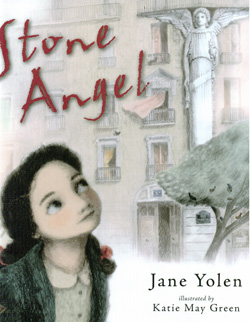Stone Angel by Jane Yolen (illustrated by Katie May Green); Penguin Young Readers, © 2015, ISBN 978-0-399-16741-6; 30 pages; $16.99
By Donald H. Harrison

 SAN DIEGO –Travelers to Paris may wish to visit 57 Rue de Turbigo, an apartment house on which a nine-meter tall stone angel is mounted, as it served as inspiration for a story that can gently introduce young readers to the subject of the Holocaust. Without describing the torture and murders that marked Nazi treatment of Jews in occupied countries, the young unnamed narrator of the book makes it clear that “bad men came” to Paris. They wore “brown shirts,” carried guns, and “made us wear yellow stars on our coats so everyone would know we were Juifs, Jews, and call us bad names and take away our houses.”
SAN DIEGO –Travelers to Paris may wish to visit 57 Rue de Turbigo, an apartment house on which a nine-meter tall stone angel is mounted, as it served as inspiration for a story that can gently introduce young readers to the subject of the Holocaust. Without describing the torture and murders that marked Nazi treatment of Jews in occupied countries, the young unnamed narrator of the book makes it clear that “bad men came” to Paris. They wore “brown shirts,” carried guns, and “made us wear yellow stars on our coats so everyone would know we were Juifs, Jews, and call us bad names and take away our houses.”
For the narrator, however, the yellow stars are not all bad. Stars remind her of the heavens, where there are angels to watch over her. The girl always thought of the stone angel as her special protector, but now she and her brother, Aron, must flee with their parents to hide in the deep woods. The children learn to stay very still in the underbrush during the day, to forage for food at night, and to speak what the narrator calls the “language of silence.”
Her father is one of ten partisans who march off one night, and several days later he is one of only four who return. Women in the camp cry, but the young narrator does not. She believes the other men have gone to be with the angels. Her father decides the family must leave the woods to traverse the Pyrenees to Spain. After this adventure, the family travels in a small boat to England, where they meet their cousin Jacob, at whose home they wait out the rest of the war. When the war ends, the family returns to Paris – and the young narrator is reunited with her angel, seen in the illustration above.
For young readers, or listeners, the story is an adventure tale of a family that sticks together, braves uprooting and hardship, and emerges from their trial whole and perhaps even closer than they ever were before. For children who are more curious, it may lead to questions like “Who were the people in the brown shirts? Why did they make people wear Yellow Stars?” Parents may calibrate their answers to the level of the child.
*
Harrison is editor of San Diego Jewish World. Your signed comment may be posted in the space provided below or sent to donald.harrison@sdjewishworld.com